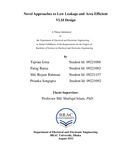Novel approaches to low leakage and area efficient VLSI Design
Abstract
The development of digital integrated circuits is challenged by higher power consumption. The combination of higher clock speeds, greater functional integration, and smaller process geometries has contributed to significant growth in power density. Scaling improves transistor density and functionality on a chip. Scaling helps to increase speed and frequency of operation and hence higher performance. As voltages scale downward with the geometries threshold voltages must also decrease to gain the performance advantages of the new technology but leakage current increases exponentially. Thinner gate oxides have led to an increase in gate leakage current. Today leakage power has become an increasingly important issue in processor
hardware and software design. With the main component of leakage, the sub-threshold current, exponentially increasing with decreasing device dimensions, leakage commands an ever increasing share in the processor power consumption. In 65 nm and below technologies, leakage accounts for 30-40% of processor power. According to the International Technology Roadmap for Semiconductors (ITRS) [1], leakage power dissipation may eventually dominate total power consumption as technology feature sizes shrink. While there are several process technology and circuit-level solutions to reduce leakage in processors, we propose novel approaches for reducing both leakage and dynamic power with minimum possible area and delay trade off.

